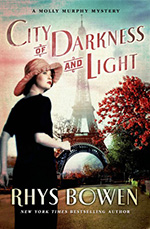There’s just one word for this book: delicious. The thirteenth installment in Rhys Bowen’s fine Molly Murphy series finds Molly at home with her new baby, Liam, when all hell – literally – breaks loose. Molly is missing her friends from across the way, Sid and Gus, who are away in Paris; and she’s missing her husband, Daniel, who is away at work almost all the time.
 When Daniel stops by for a quick bite to eat, the sound of breaking glass is the last thing Molly knows before she realizes her house has blown up and is on fire. Baby Liam is still inside as is Molly’s maid – the baby makes it out fine. Daniel realizes he’s the target of the Cosa Nostra, and he thinks it’s a good idea to send Molly and baby Liam off to Paris to stay with Sid and Gus while he works things out at home. They’ve already begged her to visit.
When Daniel stops by for a quick bite to eat, the sound of breaking glass is the last thing Molly knows before she realizes her house has blown up and is on fire. Baby Liam is still inside as is Molly’s maid – the baby makes it out fine. Daniel realizes he’s the target of the Cosa Nostra, and he thinks it’s a good idea to send Molly and baby Liam off to Paris to stay with Sid and Gus while he works things out at home. They’ve already begged her to visit.
Since her marriage, Daniel hasn’t wanted Molly to continue to operate her private eye business, but she’s found one way and another to get involved in solving various cases. In this one, after a rough ocean crossing, she and the baby finally turn up at Sid and Gus’ doorstep only to discover that they have disappeared. Molly knows it’s not like her friends to vanish when they were eagerly expecting her arrival, and she settles into their apartment (there’s a crib waiting for Liam) so she can try and find them.
She finds an agreeable baker’s wife to watch the baby during the day, and then she’s off. Sid and Gus live in a section of Paris full of artists – and the time Bowen is writing about, the very early 20th century, finds many impressionists as well as modernists like Picasso hard at work. Bowen folds Picasso, Lautrec, Gertrude Stein and Mary Cassatt into her story in the most natural way, and the most realized character turns out to be Mary Cassatt, at the time one of the most successful of all the impressionists (to the intense annoyance of many a male painter).
I never felt that Sid and Gus would be irretrievably lost – they’re too much a part of the fabric of the series – but Bowen builds suspense and tension around the murder of a successful but poorly regarded (by his peers) painter. This investigation allows Molly to visit all the strata of Paris, from the high to the low, while also giving a good picture of the vibrant artistic scene in Paris at the turn of the century.
Bowen is very skillful at characterization, and her portrayal of the various actors in the death of the painter is sensitively and vividly done. She has a concise way with words, but the words she chooses are evocative and memorable. Sending Molly to Paris turns out to be a breath of fresh air for this long running and enjoyable series, and I so look forward to Molly’s continued juggling act of her marriage, her baby, and her desire to investigate every crime she stumbles across.